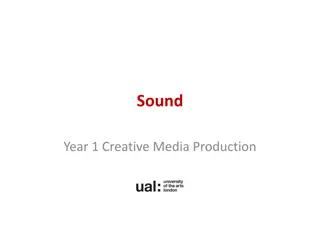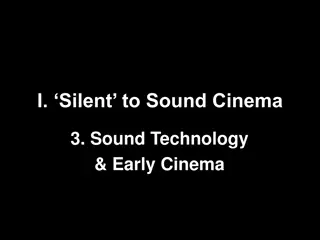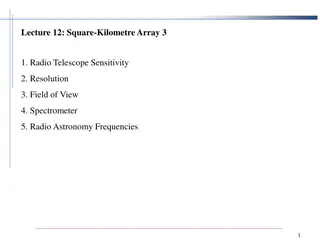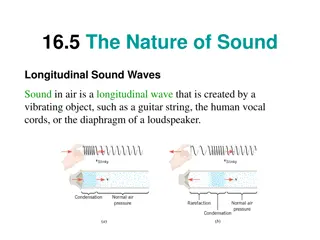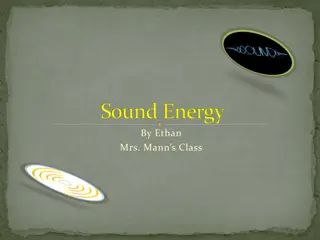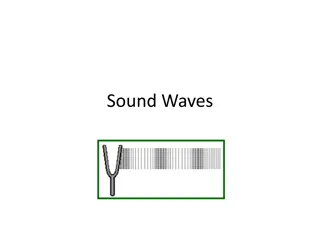Understanding Sound and Radio Technology
Exploring the significance of the rebels' first radio broadcast, the mechanics of radio communication, the production of sound through vibrations, and the importance of amplitude in sound properties. Discover how radios work, transmit signals, and impact our daily lives.
Download Presentation

Please find below an Image/Link to download the presentation.
The content on the website is provided AS IS for your information and personal use only. It may not be sold, licensed, or shared on other websites without obtaining consent from the author. Download presentation by click this link. If you encounter any issues during the download, it is possible that the publisher has removed the file from their server.
E N D
Presentation Transcript
Joseph Plunkett Two of the rebels in the 1916 Easter Rising were experts in wireless, or radio, technology. Joseph Plunkett ordered them to take over a wireless training school on Sackville Street on Easter Monday and broadcast news of the rising to the outside world. The following day, they succeeded in sending out what is thought to be the world s first radio broadcast.
What was special about the broadcast? Up until the rebels made their broadcast, radios had only been used to transmit signals to one other radio. This was known as a radio transmission. However, the rebels managed to transmit signals that could be picked up by any radio. This is known as a radio broadcast.
How does a radio work? Sound is a form of energy that travels in waves. A radio is used to send sound over a long distance through the air. Inside a radio there is a device called a transmitter. This converts sounds into electrical signals and combines them with radio waves. The radio waves are sent out through an antenna connected to the transmitter.
How does a radio work? The radio waves spread out in all directions and get picked up by other radios. Inside each radio there is another device called a receiver. The receiver separates the electrical signals from the radio waves, and converts the electrical signals back into the original sounds.
How is sound produced? Sound is produced by vibrations. Every time you speak or sing, the vocal chords in your throat vibrate and produce sound. The molecules in the air vibrate and bump into each other.
How is sound produced? This causes a ripple, or series of waves, that allows the sound of your voice to travel. When sound waves reach our ears, our eardrums vibrate and send electrical signals to our brain. The brain interprets these signals as sounds.
Amplitude a property of sound Amplitude is one of the properties of sound. It means loudness or volume. Amplitude is measured in decibels (dB). Normal rainfall measures about 50 dB, while a chainsaw measures about 100 dB. Sounds over 80 dB can damage hearing if they are repeated over a long period of time. To protect their hearing, people who work with power tools often wear earmuffs.
Amplifying sound Sounds can be amplified, or made louder, by increasing the energy level of the sound waves. For example, the harder you beat a drum or blow a whistle, the louder the sound that is produced. You can make your voice louder by speaking into a funnel-shaped instrument called a megaphone.
Amplifying sound You can also amplify sound by capturing more sound waves. Have you ever seen a character in a film listening to a conversation in the next room by holding a glass to the wall? The glass captures sound waves and directs them into the ear.
Amplifying sound Radios and other electronic devices contain an electronic amplifier that increases the energy of sound waves before sending them to a speaker. The speaker then vibrates to further increase the energy of the sound waves. If you put your hand on a speaker when music is playing, you can feel these vibrations!
Pitch a property of sound A sound can have a low tone or a high tone. This property is known as pitch. Frequency describes the speed at which sound waves vibrate. High-frequency sound waves produce a high-pitched sound, while low-frequency sound waves produce a low-pitched sound. Frequency is measured in hertz (Hz).
Pitch a property of sound Humans are able to hear sounds in a range of 64 23,000 Hz. Dogs are able to hear sounds in a range of 67 45,000 Hz. This means that dogs can hear high-pitched sounds that we cannot hear!
Pitch a property of sound An ultrasound machine is used to see inside the body. This machine produces a very high-pitched sound beyond the range of human hearing. Sound waves are transmitted into the body, where they bounce off the organ that is being examined. The machine records the waves that echo back, and uses these to generate images.
Velocity a property of sound Velocity describes the speed at which sound waves travel through a medium. Sound can travel through any medium, whether it is a solid, a liquid or a gas. However, sound waves travel faster through solids and liquids than through air.
Velocity a property of sound The velocity depends on how tightly the molecules in the medium are packed together. Sound waves travel over 17 times faster through steel than through air, and around four times faster through water than through air. But even so, the velocity of sound waves travelling through the air in your classroom is roughly 1,235 km/h or 330 metres per second!
Solid materials and velocity Some solid materials are better at conducting sound waves than others. For example, steel is a good conductor of sound waves. However, solid materials such as styrofoam and cotton wool are poor conductors of sound waves. These materials contain millions of air pockets that cause the sound to become muffled. Foam earplugs are made of a material similar to styrofoam.
Solid materials and velocity When sound waves hit a material with a hard surface, such as rock or concrete, they bounce back towards the source. This is why we hear our voice echoing in a large empty space, such as a cave. It also explains why sounds are louder in certain small spaces, such as tiled bathrooms.
Illustrations Shutterstock Beehive





